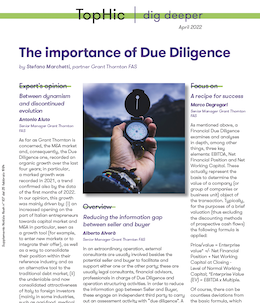-
Transactional advisory services
Find out more about the transactional advisory services of Grant Thornton Financial Advisory Services
-
Valuations
Find out more about the valuations services of Grant Thornton Financial Advisory Services
-
Mergers and acquisitions
Find out more about the merger and acquisition services of Grant Thornton Financial Advisory Services
-
Forensic and investigation services
Find out more about the forensic and investigation services of Grant Thornton Financial Advisory Services
-
Recovery & reorganisation
Find out more about the Recovery & reorganisation services of Grant Thornton Financial Advisory Services
-
Business risk services
Find out more about the business risk services of Grant Thornton Financial Advisory Services
-
Business consulting
Find out more about the business consulting services of Grant Thornton Financial Advisory Services
-
Capital market
Capital market
-
Corporate and business tax
Find out more about our corporate and business tax services.
-
Direct international tax
Find out more about our direct international tax services.
-
Global mobility services
Find out more about our global mobility services.
-
Indirect international tax
Find out more about our indirect international tax services.
-
Transfer pricing
Find out more about our transfer pricing services.
-
Litigation
Our lawyers and accountants can manage all defense measures provided not only by the Italian law, but also by EU regulations and conventions
-
Family business
Find out more about our Family business services.
-
Legal
The client can be assisted in every need and with the same care both on important operations or disputes and on simple matters

-
Back office outsourcing
Find out more about our Back office outsourcing services
-
Business process outsourcing
Find out more about our business process outsourcing services.
-
Compilation of financial statements
Find out more about our compilation of financial statements services.
-
Tax compliance
Find out more about our tax compliance services.
-
Electronic invoicing
Find out more about our electronic invoicing services
-
Electronic storage
Electronic storage is an archiving procedure that guarantees the legal validity of a digitally stored electronic document
-
Revaluation of corporate assets
Find out your civil and fiscal revaluation of tangible, intangible and financial assets
-
Payroll
Complete and customized payroll service, integrated with digital solutions and compliant with Italian and international regulations.
-
Labor consultancy
We help Italian and international companies manage all aspects of their workforce.
-
HR & Payroll Advisory Services
We review contracts, payroll, and risks for extraordinary transactions and we assess tax, labor, and safety risks in outsourcing contracts.
-
Extended services
We provide integrated digital tools to simplify HR management.
-
HR Infinity Portal
The HR Infinity Portal is Zucchetti’s platform designed to centralize communication between the company and its employees.
-
Cybersecurity
GT Digital helps clients structure information security management internal functions, also through partially or totally outsourced functions
-
Agile and Programme Management
GT Digital provides support in the adoption and implementation of different portfolio management
-
Robotic Process Automation
Our “BOT Farm” can rely on digital workers able to help clients in routine activities, allowing employees to deal with more added-value activities
-
Data strategy and management
GT Digital can support clients in seizing the opportunities offered by Big Data, from the definition of strategies to the implementation of systems
-
Enterprise Resource Planning
We support clients in selecting the most appropriate ERP System according to their specific needs, helping them also understand licensing models
-
IT strategy
GT Digital supports clients in making strategic choices, identifying innovation opportunities, comparing themselves with competitors
-
IT service management
We can support with software selection and with the implementation of dedicated tools for the management of ICT processes
-
DORA and NIS 2
The entry into force of the DORA Regulation and NIS2 represents a major step towards the creation of a harmonised regulatory framework
In an extraordinary operation, external consultants are usually involved besides the potential seller and buyer to facilitate and support either one or the other party; these are usually legal consultants, financial advisors, professionals in charge of Due Diligence and operation structuring activities.
In order to reduce the information gap between Seller and Buyer, these engage an independent third party to carry out an assessment activity with “due diligence”. A Due Diligence is mainly aimed at:
- confirming the strategic rationale of the transaction;
- confirming the preliminary valuation included in the letter of intent;
- identifying any risk factors, critical issues and opportunities.
Due Diligence activities can be of different nature, i.e.: Financial/Accounting, Commercial, Tax, Legal, HR/Payroll, IT, Reputational and ESG.
Financial Due Diligence
Financial Due Diligence plays an essential role within an M&A transaction, since it analyses the company’s performance, in order to explain its economic/financial evolution, it identifies possible risks and opportunities and substantiates the valuation criteria previously agreed upon by the Seller and the Buyer. The recipients of a Financial Due Diligence are not only the potential buyers, but also those who, either directly or indirectly, are exposed to the success of the transaction (e.g. debt financiers).
As mentioned above, one of the key objectives of a Financial Due Diligence is that of validating the economic/asset foundations underpinning the valuation of the company object of the transaction. The following three analyses are therefore essential:
- analysis of the normalised EBITDA,
- analysis of the seasonality of the normalised Net Working Capital, and
- analysis of the normalised Net Financial Position.
To this end, a clarification is necessary: the calculation and the determination of the three indicators above are irrespective of the mere application of mathematical formulas, since their determination mainly depends from: (i) market praxis, (ii) negotiations between the parties and (iii) subjective expectations of the potential buyers in the post-acquisition scenario (e.g. a competitor has different expectations compared to a financial buyer).
In addition to the above, a Financial Due Diligence will focus on the analysis of:
- the main revenue and marginality growth drivers;
- the cost structure;
- the cash generation capacity;
- the investment policies adopted;
- the Net Working Capital structure; and
- the structure of the net debt and of potential liabilities.
A Financial Due Diligence is usually carried out considering a three-year timeframe, since such period guarantees a more stable outlook of the company’s economic and assets’ trends, identifying possible non-operational or non-recurring phenomena which may have distorted its historical performance.
Basing on the assisted company, a Due Diligence can be:
- Buy-Side, i.e. supporting the buyer. The Buy Side Due Diligence report is aimed at confirming the valuation and strategic rationale assumed by the Buyer for a given acquisition;
- Vendor-Side, i.e. supporting the vendor/seller. The Vendor Due Diligence report, or Vendor Assistance report, includes all the analyses present in a Buy-Side report, but with more in-depth details, since there is full access to the corporate information. A Vendor Due Diligence has a twofold aim: (i) that of allowing the Vendor and its consultants to identify in advance possible issues and opportunities related to the transaction and, thus, devise a better drafting of the agreement in terms of perimeter and/or timelines, and (ii) streamlining the acquisition process both in case of competitive bidding and of exclusive negotiation, since the Due Diligence activity helps identifying potential issues or liabilities from the start (with the exclusion of negotiation or subjective issues) also for potential Buyers.
Due Diligence is not a mandatory activity in an M&A operation, but is increasingly more used, also in middle market operations (i.e. those in which the target company has a turnover between €5m and €250m). Since there is no authoritative literature or common standards on how to perform a Financial Due Diligence, it is key to contact a team of professionals with a significant market experience.
In short, a Due Diligence is always useful, both when it confirms the Buyer’s expectations and the deal is closed, and when (most importantly) the operation is not successful, as it prevents the investor from closing a bad deal.

